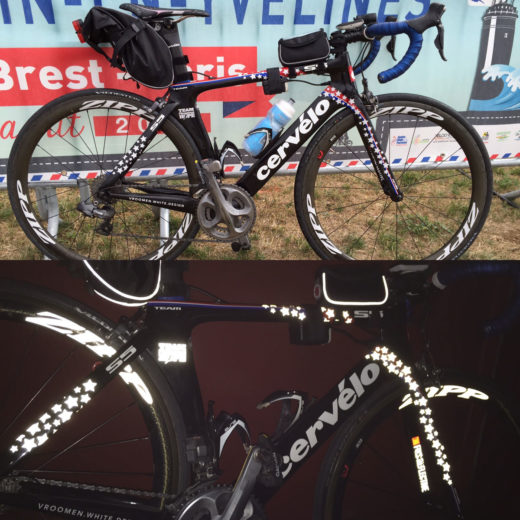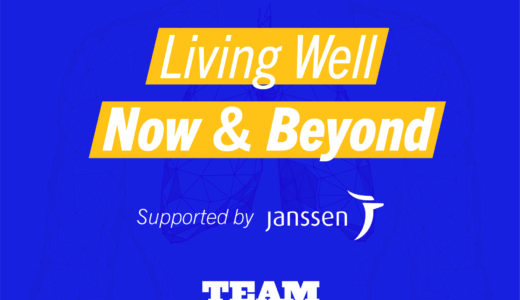Paris-Brest-Paris – the Gear

So what about the bike?
When contemplating Paris-Brest-Paris (PBP), or any randonneur long distance rides, perseveration over gear becomes common. In this blog post I want to share my perseveration with you, in case you’re contemplating PBP, or wondering how this equipment fared over the super long haul.
In this solo sport where you’re riding often alone on country roads after midnight, maybe in rain, durability and reliability become essential. This area of cycling is about being able to sustain yourself and your bike. I often say that randonneur is French for “ride really far and take care of your own bike.”
In big randonneur events, one often sees a variety of steel framed beauties with Dynamo hubs powering their lights and electronics using friction from the wheel. Riders on these bikes won’t run out of power as long as they pedal, and I’ll be honest, some of those lights are really bright. You’ll also see a number of carbon framed racing bikes and carbon wheels, so there is as great a variety of bikes as rider styles in this event.
When I went into this randonneuring business I didn’t have a steel bike. But I had a very trusted bike that had carried me successfully though 4-woman team RAAM, Race Across the West, multiple RAAM Challenge races, and other ultra races and rides. So it seemed more than up to the task.
Enter the Cervelo S5, my randonneur bike
My steed of choice for much of the qualifiers was my former carbon bike, but when I had some heavy neck and foot problems after the Ohio 600km I went back to the bike that fit like a glove: my aero framed Cervelo S5 Team.
Equipped with Shimano Ultegra Di2 shifting and Zipp 303 clinchers and handlebar, Vredestein Fortezza TriComp tires, Selle Italia women’s saddle, this bike is stiff but also the most comfortable bike I own. My goal wasn’t to be truly aero for the event, but it wouldn’t hurt. I would be weighing it down a fair bit with gear, but even those bags were chosen to help keep the front end light and minimize the carry.
For bags I carried the Banjo Brothers waterproof saddle trunk bag, which didn’t require a pannier to mount, and their small top tube bag for quick reach stuff. My jersey pockets stayed light, carrying mainly only my phone and a GoPro camera.
This bike continued to feel great. It traveled well without any problems with disassembly and reassembly. I had had a precise fit from Glenn Pawlak at Big Bang Bicycles, and he spent some time tweaking this leading up to the event, which turned out to make a huge difference.
The Di2 battery lasted the entire trip of 764 miles without any issue, and sure juice to spare (I plan to keep testing it to see how long until I need a charge). The Zipp handlebars and wheels absorbed the road better than my aluminum training wheels, and with Di2 shifting making the shifting so easy and fluid, I’m certain this setup saved arm and upper back fatigue. Even more key, I never dropped my chain during the ride. Not that I’m a horrid shifter, but I definitely have come to enjoy the reliability of Di2 shifting.
Accessories – lights and electronics and more
Without a Dynamo hub, riders must choose to go with battery-powered light versus a power pack. Again, we had used DiNotte XML-3 headlights in RAAM and RAW, these lights from ultra races that were super bright, lasting 10h on their 25% power setting and still completely lighting the way. The downside being they have to recharge using a power cord to a wall outlet or car converter. But traditional battery-powered lights come no where close to these lights for brightness, and the more visibility you have at night, the further you can see and less likely you are to get lost.
I decided to use the DiNotte system used in all my ultra races until now, and bring 2 back up battery packs. One lived in my bag the whole time for emergencies. The other I swapped with my crew at night for them to charge in their hotel room. Could this setup have lasted without a charge? Quite possibly. With 20 hours of charge time and me pedaling on average 6-8 hours in the dark, I may have been able to get through without a charge. Although I didn’t want to test it in PBP. I will test this in rides to come.
For taillights I ended up using the Seattle Sports Blazer Red Rear Bike Light from REI, powered by a replaceable battery. This simply strapped around the seat stay and was listed as providing 100 hours of light or so. In PBP you have to use the constant, not blinking, setting, which uses more juice, but I had no problems. The only minor issue was trying to turn it off at a control the first night after some rain and road spray. It seemed sticky, probably from the rain. I never needed my spare, however, so it worked out fine.
To maximize my visibility to drivers and riders on the road I had custom reflective stars added to my striped frame by Fiks:Reflective. This look not only got so many comments from other riders, but helped keep me even safer as I represented my home country. The frame stars rocked.

As for the Garmin, I used two Garmin monkey batteries to charge on the go. These extend the battery life of the Garmin by at least 20 hours. Using the Garmin Edge 510, this meant that it’d extend the battery from 15h to well over a day. Again with a crew meeting me at controles I didn’t tempt fate. Rather we would trade the monkey so I always had fresh power.
For communications and camera I carried my iPhone 6 with a Mophie Juice Pack Plus battery case. I charged this at night when I slept for a few hours. I also carried my GoPro Hero 4 camera to more easily draw and shoot photos and video on the road.
Supplies
My top tube bag was used mainly for nutrition at my fingertips, salt stick tablets, and the cue sheet. The seatpost trunk bag was the workhorse of the storage. Able to expand and contract, waterproof and durable, it did the job carrying:
- my rain jacket and reflective vest when not in use during the day on top
- spare battery pack for headlights
- spare taillights (2) battery-powered
- spare headlight, battery-powered
- 2 innertubes and patch kit
- 3 CO2 cartridges and hand pump (enough to get you from a flat to a controle)
- winter gloves, arm warmers, knee warmers
- sunscreen
- nutrition bag
- glasses and spare contacts
- money
Nutrition
Although every controle had food and their was food in between I also carried my own fuel to speed things up and make sure I would get what I needed. I used Generation UCAN for my carbohydrate and Beet Boost reliably in my fuel bottle. As a recovery I carried Vega Sport recovery accelerator for my pre-sleep drink. For food I carried macadamia nuts and dried apricots.
Things I packed but did not carry or use on the ride:
- Backup USB-rechargeable tail lights. We had used the Light in Motion taillights in RAW and they were excellent, but I did not know how long they would truly last and the need to recharge them concerned me in this ultra distance randonneur event. I would consider in the future, but would need to test them more. They were proven to be great for ultra races where you have a vehicle following you that can recharge the spare.
- Extra CO2 and Innertubes – I had 3 more cartridges and 2 more tubes, but quite honestly the roads in France are so amazing (I never saw broken glass and potholes are extremely rare), that I didn’t flat.
Drop bag
So PBP offers a drop bag service, but given I had a crew they were my drop bag provider, leaving a kit change at the hotel in Loudeac and picking up that bag after I had left. It worked well and avoided searching through a truck for a bag in the middle of the night. But for future riders, know there are several options to get a clean kit change mid ride without having to carry it on your bike (space being more an issue to me than weight of a kit).
The Bike CASE – Biknd
To get my bike abroad I went with the recommendation of my friend Greg, who has traveled numerous times to Europe with his bikes. I used the Biknd Helium Bike Case, which is a soft case that you assemble around your bicycle, utilizing an air cushion to protect the frame. It is fabulous for many reasons.

First, it protects the bike. The bike is super stable mounted within the case, so no problem there. Second, it is very portable, with the ability to pull it on its wheels like one would a suitcase. There are numerous handles for lifting it in and out of a vehicle, so it is just completely easy. And finally, when you arrive at your destination, the case collapses so it is more manageable than the hard, clunky cases. I highly recommend this case, and look forward to using it in future adventures with my bicycle.
There it is, my PBP 2015 gear. Turned out this setup all worked great. My trusted carbon framed Cervelo race bike does quite well in these long distance events, the Shimano Di2 shifting was a dream, and Zipp wheels provided additional road-absorbing comfort in this ride. I’ll definitely ride my Cervelo S5 in future randonneur rides for sure, and now with this experience behind me, likely take much less backup gear.



